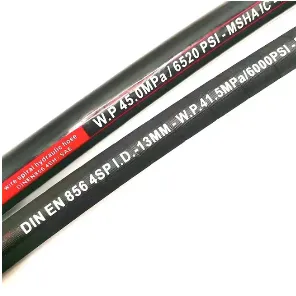335345435
Nov . 21, 2024 15:27 Back to list
Innovations in Hydraulic Hose Technology
The hydraulic industry has experienced significant advancements in recent years, with innovations in hydraulic hose technology leading the way. These developments aim to enhance performance, increase durability, and improve safety. Understanding these innovations is essential for professionals seeking to optimize their hydraulic systems.

Advanced Materials for Enhanced Performance About Hydraulic Hose
One of the most notable trends in hydraulic hose technology is the introduction of advanced materials. Traditional rubber hoses have been the standard, but new synthetic materials are now being utilized to improve resistance to heat, abrasion, and chemicals. Thermoplastic elastomers (TPE) and fluoropolymers are increasingly popular due to their superior flexibility and durability. These materials not only extend the lifespan of the hoses but also reduce the risk of failure in demanding environments.
Moreover, the development of lightweight composite materials is revolutionizing the industry. These materials provide the same strength and durability as traditional hoses while significantly reducing weight. This innovation is particularly beneficial in mobile applications, where reducing weight can lead to improved fuel efficiency and easier handling.
Enhanced Safety Features With Hydraulic Hose
Safety is paramount in hydraulic systems, and recent innovations focus on minimizing risks associated with hose failures. One significant advancement is the integration of burst indicators and pressure monitoring systems directly into hydraulic hoses. These technologies allow operators to monitor the condition of the hose in real time, providing alerts before a failure occurs. Such proactive measures help prevent accidents and costly downtime.
Additionally, the introduction of fire-resistant hoses has become increasingly important, especially in industries where high temperatures are common. These hoses are designed to withstand extreme heat, providing an extra layer of safety in hazardous environments. The use of heat-resistant materials and protective coatings ensures that the hose can perform reliably under challenging conditions.
Smart Technology Integration About Hydraulic Hose
The rise of the Internet of Things (IoT) has also influenced hydraulic hose line technology. Smart hoses equipped with sensors can provide valuable data regarding pressure, temperature, and fluid flow. This real-time monitoring allows for predictive maintenance, enabling operators to identify potential issues before they escalate into serious problems. By analyzing data collected from smart hoses, companies can optimize their maintenance schedules, reduce costs, and increase operational efficiency.
Furthermore, the use of digital twins in hydraulic systems is gaining traction. A digital twin is a virtual model that reflects the physical system in real time. By simulating different conditions and scenarios, operators can better understand how hydraulic hoses will perform under various circumstances, leading to improved design and selection processes.
Improved Design and Manufacturing Techniques With Hydraulic Hose
Innovations in design and manufacturing have also played a crucial role in enhancing hydraulichoses technology. Advances in computer-aided design (CAD) and simulation software allow engineers to create more efficient and effective hose designs. This enables the production of hoses that better meet specific application requirements, resulting in improved performance and reliability.
Additive manufacturing, or 3D printing, is another revolutionary technique being utilized. This technology allows for rapid prototyping and customization of hydraulic hoses. Manufacturers can create complex geometries and tailored solutions quickly, reducing lead times and enhancing product offerings.
Sustainability in Hydraulic Hose Production
As environmental concerns become more pressing, the hydraulic industry is also focusing on sustainability. Innovations in hydraulic hose technology are increasingly aimed at reducing the environmental impact of production and disposal. Manufacturers are developing eco-friendly materials that are both recyclable and biodegradable, addressing the growing demand for sustainable products.
Additionally, advancements in manufacturing processes are leading to reduced energy consumption and waste. By implementing lean manufacturing principles and optimizing production techniques, companies can minimize their carbon footprint while maintaining high-quality standards.
Future Trends in Hydraulic Hose Technology
Looking ahead, several trends are likely to shape the future of hydraulic hose technology. The continued integration of smart technology will lead to even more sophisticated monitoring and control systems, enhancing efficiency and safety. As industries increasingly adopt automation and robotics, hydraulic hoses will need to adapt to meet the demands of these advanced systems.
Moreover, the exploration of nanotechnology in materials science may yield new opportunities for enhancing hose performance. Nanomaterials could offer improved strength, flexibility, and resistance to wear and chemicals, pushing the boundaries of what hydraulic hoses can achieve.
-
LPG Hose for Sale: A Wholesaler’s Guide to Sourcing Safe and Profitable Solutions
NewsJun.23,2025
-
Rubber Pipes for Sale: A Wholesaler’s Blueprint for Sourcing Premium Industrial Solutions
NewsJun.23,2025
-
Hydraulic Hose Wholesale: A Wholesaler’s Playbook for Strategic Sourcing
NewsJun.23,2025
-
Power Washer Hoses for Sale: A Wholesaler’s Guide to Smart Sourcing
NewsJun.23,2025
-
Hydraulic Fittings for Sale: A Wholesaler’s Guide to Mastering Compatibility and Compliance
NewsJun.23,2025
-
Hydraulic Pipe Crimper for Sale: A Wholesaler’s Guide to Sourcing Premium Crimping Solutions
NewsJun.23,2025



